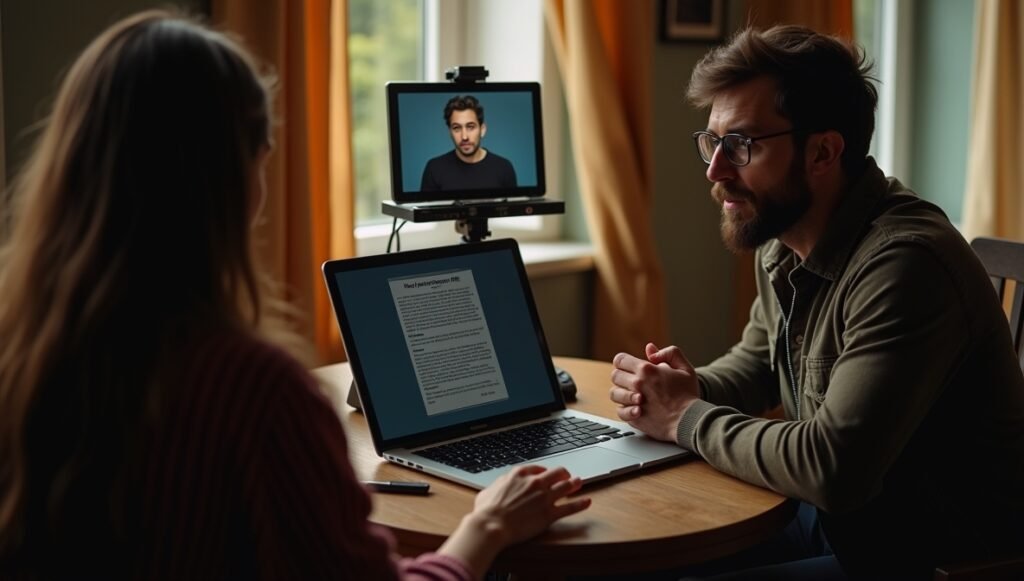Introduction
For actors, the script is everything. It’s the plan, the guide, the music. Inside, words wait to create a character. These words push the story. They touch the audience. But first, a crucial step: memorizing lines. The need to be “off-book” quickly and correctly can feel huge. This is true for auditions, rehearsals, or showtime. But here’s good news. Learning lines isn’t just about hard work. It’s a skill you can build. Smart methods and regular practice make a big difference.
This guide offers many script memorization hacks. They help you learn lines fast. More than that, they help you learn lines well. This deep learning lets you act truly in the moment. We will look at ways to use different parts of your brain. We’ll connect your body and mind. These tips change line learning from a chore to a key part of building your character. Forget just repeating words. Let’s find ways to make those words yours. This means you don’t just remember them; you live them.
Section 1: The Foundation – Understanding Before Memorizing

Before you learn even one line, you need to understand. Think of it like building a house. You need a strong base first. If you just try to memorize words without knowing the story, character, or problem, the lines will feel empty. They won’t stick. Real memorization starts with a deep look into the script’s world. It means knowing your character’s place in it. This first step makes words on a page meaningful. They become part of your character’s journey.
This early work means looking at the whole script, not just your parts. You need to know the main story. Understand the writer’s big ideas. See how characters connect. For your role, find out what your character wants in each scene. What drives them? What are their feelings? How do they use words? Why do they say what they say? Who are they talking to? Knowing these things gives meaning to the lines. The lines then make sense as part of who the character is.
Building Understanding:
- Read the Whole Script: Don’t just skim your scenes. Know the full story, all characters, and the main idea.
- Know Your Character: Make a backstory. What do they believe, fear, want? What’s their history?
- Find Objectives: In each scene, what does your character want? What stops them? How do their lines help them?
- Look for Subtext: What does your character really mean? Find the hidden thoughts and feelings.
- Map Relationships: How does your character connect with others? How does this change their words?
- Note Beats and Shifts: Break scenes into smaller parts or “beats.” These are points where feelings or plans change. Knowing these helps lines make sense.
Section 2: The First Pass – Breaking Down the Text

Once you understand the script and your character, you can look at your lines. This isn’t memorizing yet. It’s about getting to know the text. You break it into smaller parts. The goal is to feel the rhythm and flow of the words. If you rush this, you might only learn the surface. The lines won’t feel connected to you. A careful first pass helps you learn more deeply.
During this step, work actively with the script. Read your lines out loud. Listen to how they sound. Notice pauses and how your character speaks. Mark up your script. Underline important words. Note changes in emotion. Write down questions. Using your hands on the script helps your brain remember. You are changing the script from just words on a page. It becomes something you are working with and figuring out.
Effective First Pass Techniques:
- Read Aloud Many Times: Hearing the words helps you know them. Try saying them in different ways (but don’t decide on one way yet).
- Chunking: Break long speeches into small parts. Learn one small part before you learn the next.
- Find Keywords and Cues: Find the words in other characters’ lines that trigger your line. Find important words in your own lines.
- Paraphrase: Try saying your lines in your own words. This shows if you understand the meaning, not just the exact words.
- Mark Your Script: Use pens and notes. Mark why your character says things, what they do, or hard words. Mark anything that helps you connect.
- Record Yourself: Listen to how you sound reading the lines. This can show you where you don’t understand or where it doesn’t flow well.
Section 3: Active Memorization Techniques – Engaging Your Brain

You understand the script. You’ve broken down the text. Now, you can start to actively memorize. This is where you use specific methods to learn the lines. “Active” is the key word. Just repeating lines without thinking doesn’t work well. It’s slow and doesn’t help you learn deeply. Active ways use more parts of your brain. This makes memories stronger. It helps you remember lines even when you’re nervous.
No single method works for everyone. Actors learn in different ways. Some learn by hearing, some by seeing, some by doing. The best way is often to use a mix of methods. Try the ideas below. See what works best for how you learn. The goal isn’t just to know the words. It’s to know them so well you can forget them and just act.
Powerful Active Memorization Strategies:
- Write Lines Out: Write your lines by hand. Moving your hand helps your brain remember. Do this many times for hard parts.
- Record and Listen: Record your cue lines. Leave spaces for your lines. Then record your lines. Listen to this often – when you travel, exercise, or do chores.
- Cover-Up Method: Cover your lines with paper. Try to say them, looking only at the cue. Slowly show less of your line as you learn it.
- Line Runner Apps: Use apps like Rehearsal Pro or LineLearner. These apps can record scenes, play other lines, and test you.
- Teach the Lines: Explain your lines and their meaning to someone. Teaching helps you remember and understand better.
- Mnemonic Devices: For hard phrases, make acronyms, rhymes, or clear mental pictures. These tricks help lines stick.
- Chunk and Chain: Learn small bits of text. Then, slowly link them together. Make sure you can move smoothly from one bit to the next.
Section 4: Incorporating Movement and Physicality

Memorizing isn’t just for your brain. Your body can help a lot. When you connect lines to actions or movements, you remember them better. Even just walking while you practice helps. Our brains remember experiences better than plain facts. When words and movement go together, the memory is richer. It uses more senses and is easier to recall.
This is sometimes called kinesthetic learning. It can be simple, like pacing while you say lines. Or it can be more involved, like acting out the scene as you learn. Moving keeps you interested. It stops you from getting tired of sitting and staring at a page. Also, thinking about how your character moves while speaking helps you learn. It also helps you build your character. The lines feel more natural.
Physicalizing Your Lines:
- Walk and Talk: Say your lines while walking. The rhythm of your steps can match the rhythm of the words.
- Gesture Link: Give a special gesture to a hard line. The physical cue can help you remember the words.
- Block It Out (Roughly): If you know how the scene is staged, move around as you say your lines. Connect lines to certain spots or movements.
- Be the Character: Practice lines while using your character’s posture and way of moving. This links the words to the physical character.
- Everyday Tasks: Try saying lines while doing simple chores like washing dishes. A little distraction can actually help lines stick.
- Emotion-Body Link: Connect lines to how emotions feel in your body (e.g., tight fists for anger, fast breath for fear).
Section 5: The Power of Repetition – Smart, Not Just Hard

Repetition is key to memorizing. But how you repeat is important. Repeating without thinking can make your acting flat. It can also make lines easy to forget under pressure. Smart repetition is active. It’s varied. It’s spread out over time. It means going over the material in different ways and at good times. This strengthens memory and makes it easier to recall lines.
“Spaced repetition” is a very useful idea. Don’t try to learn everything at once for hours. Instead, have short, frequent practice times. Look at lines you’ve “learned” again after a few hours. Then look at them the next day. Then a few days later. This is much better for remembering long-term than one long session. Each review makes the memory stronger. Changing how you repeat also helps. Sometimes focus on speed. Sometimes on emotion. Sometimes practice with a partner. This keeps it interesting and prepares you for acting.
Implementing Smart Repetition:
- Spaced Repetition Plan: Learn lines. Review them an hour later, then before bed, then next morning, then a few days later. Change this based on how hard the lines are.
- Varied Delivery: Once lines are mostly learned, say them in different ways: fast, slow, angry, sad, quiet, loud. This makes you flexible.
- Cue-to-Cue Work: Focus only on the last few words of your cue and the first few words of your line. This makes your pick-ups sharp.
- Random Order Test: Test yourself by saying lines out of order. This makes sure you know them on their own, not just in a sequence.
- Interleaving: Mix up the scenes or speeches you work on. Don’t just drill one part over and over before moving on. This slightly harder practice builds stronger memory.
- “Forget” and Re-learn: It’s okay to almost forget a line. The effort to remember it (and re-learn if needed) actually makes the memory stronger.
Section 6: Leveraging Technology and Partners

Today, actors have many tools to help learn scripts. There are also timeless methods, like working with a partner. Technology offers easy ways to drill lines. A scene partner gives real-time practice. This is close to how acting really feels. Using both tech and partners can help you learn faster and better.
Line-learning apps can be like a tireless partner. They give you cues. They let you record and test yourself when you want. They are great for practicing lines while you travel or when no one else can help. But nothing truly replaces working with another actor. A good partner gives accurate cues. They also help you find the deeper meaning, energy, and rhythm of the lines. This takes your memorizing beyond just saying words. It becomes about really connecting and responding.
Using Tools and People:
- Line-Learning Apps: Try Rehearsal Pro, Script Rehearser, or LineLearner. Many let you record other lines and test yourself.
- Audio Recording: Use your phone to record all the lines. Play it back and say your lines with the recording. Or, record only other characters’ lines, leaving spaces for yours.
- Digital Flashcards: Use apps like Anki or Quizlet. Make digital cards with cues on one side and your lines on the other. These often use spaced repetition.
- Find a Good Partner: Work with other actors learning lines. Plan regular times to practice.
- Set Rules with Partners: Decide how you want to work. Do you want them to stop you on mistakes? Or give notes after? Say if you are just memorizing or also working on acting choices.
- Online Reading Groups: If you can’t find partners nearby, use video calls to run lines with actors far away.
Section 7: Overcoming Memorization Roadblocks and Plateaus

Even with good methods, every actor gets stuck sometimes. Some lines just won’t stick. A long speech can feel too big. You might feel like you’re not making progress. These times are frustrating. But they are normal. The important thing is not to give up. Have plans ready to deal with these problems.
When a line is hard, try a new approach. If one method doesn’t work, try another. Sometimes, a short break helps. Coming back with fresh eyes can make a big difference. For long speeches, break them into even smaller parts. Focus on the main idea or emotion. This can help you find new ways to remember. Keep trying and use smart problem-solving when you hit these bumps.
Tackling Memorization Challenges:
- Focus on Problem Lines: Write them out many times. Say them ten different ways. Make a clear, even silly, mental picture for them.
- Ask “Why?”: If a line won’t stick, think about its meaning again. Do you really know why your character says it? What do they want?
- “First Letter” Trick: For lines you almost know, write down just the first letter of each word. This can surprisingly help you remember.
- Change Your Space: If you always practice in one spot, try a new place. A new view can help your focus.
- Take a Break and Sleep: Your brain stores memories when you sleep. If you’re stuck, stop. Rest. Try again later or the next day.
- Work on Cue Pickups: Practice the change from the cue line to your line. Sometimes the problem isn’t the line itself, but starting it smoothly.
- Reconnect to Character Goal: If stuck, go back to what your character wants. How does this line help them get it? Thinking about this can often solve the block.
Section 8: Testing and Proofing – Ensuring Accuracy and Flexibility

Feeling like you “know” your lines is not enough. You must test your memory hard. This ensures you are accurate. It also makes sure you can recall lines in different situations. This testing step builds confidence. It prepares you for the surprises of rehearsals and shows. You want to move from shaky memory to strong, flexible knowledge.
Testing can happen in many ways. You can self-test by covering the script. You can run lines with a partner who tries to distract you. Or they might say their lines differently. The goal is to create some of the pressure you might feel. Can you still say your lines right if your partner misses a word? Or if there’s a sudden noise? The more you test your memory in a safe place, the stronger it will be when it matters.
Rigorous Testing and Proofing Methods:
- Speed-Throughs: Say your lines as fast as you can with a partner. Focus only on being right and on cues, not on acting. This shows any weak spots.
- Distraction Drills: Try saying lines while doing something simple that distracts you (like bouncing a ball). Or have someone try to gently distract you (make faces, play soft music).
- “Italian” Rehearsal: This is like a speed-through. You say lines very fast, often with big energy but no real blocking. It helps lock in words and pace.
- Get a “Tough” Line Reader: Ask a partner to be very strict. Have them stop you for any small mistake, wrong word, or missed word.
- Out-of-Order Test: Have someone say random cue lines from anywhere in the script. See if you can jump in right away with your line.
- Record and Review: Record yourself saying lines (sound or video) without the script. Watch or listen carefully. Note any pauses, mistakes, or times you weren’t smooth.
- Practice with Intentions: Once lines are strong, say them focusing only on what your character is trying to do with those words. This locks meaning with the text.
Section 9: Maintaining Lines for Long Runs and Repertory

Actors in long shows or those who do many plays (repertory) have a special challenge. They don’t just learn lines. They have to keep them right for a long time. They also have to switch between different scripts. Lines that were once easy can fade. Or they can get mixed up with other roles if not actively kept fresh. This needs a different kind of focus and specific ways to keep the text sharp.
Regular, short reviews are key. Don’t wait until you feel lines slipping to look at them again. Add short line runs to your warm-up. Or plan times to review, especially for roles you don’t do often. For repertory, make clear differences in your mind between characters and plays. This helps stop “bleed-through” where lines get mixed up. Staying active with the text, even after many shows, keeps it alive and right.
Long-Term Line Maintenance:
- Plan Brush-Up Times: Even a quick run of scenes helps. Make time to review the text often during a long run.
- Pre-Show Line Check: Before each show, quickly go over hard parts or the whole script. Do what you need.
- Re-Read the Script: Sometimes, read the whole play again (not just your lines). This helps you reconnect with the story, ideas, and your character’s full path. It can refresh your lines.
- Focus on Character (for Rep): When you switch roles, take a moment. Think about the new character’s body, voice, and main goals before saying lines. This helps keep things separate.
- Keep Scripts Near: Don’t put away scripts for shows you might do again. Keep them easy to find for quick reviews.
- Help Each Other: If you’re in a long run, other actors can help. Offer to run lines together. It helps everyone.
- Note Changes: Watch out for small new words or changes that sneak in over time. Check back with the real script sometimes to stay accurate.
Conclusion
Learning to memorize scripts well is a skill that grows. It’s a core ability for actors. When you use smart plans and steady work, you can do more than just say words. You can find the heart of your characters and stories. The tips in this guide offer many ways to learn. From understanding first, to active learning, to using tech, to hard testing – these tools help. They make the process faster, better, and part of your acting craft.
Remember, every actor learns differently. Try these hacks. Change them to fit how you learn. Find what works best for you. The aim is to know your lines so well they feel natural. This frees you to live truly in the world of the play. With effort and the right methods, you can change line learning. It can go from something scary to a strong step toward great acting.

